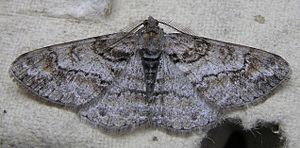Ringspot bark tensioner
| Ringspot bark tensioner | ||||||||||||
|---|---|---|---|---|---|---|---|---|---|---|---|---|

Ringspot crustacean ( Cleora cinctaria ) |
||||||||||||
| Systematics | ||||||||||||
|
||||||||||||
| Scientific name | ||||||||||||
| Cleora cinctaria | ||||||||||||
| ( Denis & Schiffermüller , 1775) |
The Ringfleck-Barkspanner ( Cleora cinctaria ), also called Ringfleck-Baumspanner or Schwarzes O , is a butterfly ( moth ) from the family of Spanner (Geometridae).
features
butterfly
The wingspan of the moth is 28 to 33 millimeters. The wings are light gray in the basic color and show brownish drawing elements. The intensity of the gray or brown color varies quite a lot. The inner transverse line is broadened like a ribbon towards the root, the outer one runs in an arched manner towards the front edge and is usually double. A white wavy line and a light wipe can be seen in the brownish, darkened hem area. On the hind wings there are dark transverse lines and a mostly indistinct whitish wavy line. The first abdominal segment appears in the form of a white belt. The antennae of the males are combed on both sides, those of the females are thread-shaped.
Egg, caterpillar and pupa
The light green egg shows a red and green iridescent skin and is covered on the surface with 30 wavy ribs, which also have transverse serrations. The Mikropylrosette is six to seven leaved.
Adult caterpillars are green in color and have whitish longitudinal lines.
The light brown doll is piston-shaped and has a button-shaped cremaster with a long fork tip. The wing sheaths shimmer green.
Similar species
The Ringfleck-Barkenspanner is similar to other types of bark tensioners, especially Synopsia sociaria , but differs in the rounded course of the outer transverse line.
Geographical distribution and habitat
The species occurs from the Iberian Peninsula across Europe to Mongolia and southern Siberia to Japan . In Scotland it is by the ssp , C. cinctaria bowesi , in East Asia by the ssp. C. cinctaria superfumata represented. The habitat of the species includes a wide variety of areas, for example mixed forests, bog forests, bushes, orchards , semi-arid grasslands as well as heaths, gardens and parks. The species rises up to 1500 meters in the Alps .
Way of life
In Central Europe, the Ringfleck-Rindenspanner usually forms one generation per year, the adults of which can be found from the end of March to the end of June. A second generation is trained in July and August under favorable climatic conditions. In the southern Alpine valleys, butterflies were also found in September and October. They are nocturnal and come to artificial light sources , preferably the males. Sometimes the moths appear in large numbers on the bait and have also been observed sucking on willow flowers. During the day they like to rest on tree trunks. The caterpillar feeds polyphagously on the leaves of various plants, including:
- Scots pine ( Pinus sylvestris )
- Silver birch ( Betula pendula )
- Blackthorn ( Prunus spinosa )
- Red vetch ( Securigera varia )
- Broad-leaved thyme ( Thymus pulegioides )
- St. John's wort ( Hypericum )
- Heather ( erica )
- Bogberry ( Vaccinium uliginosum )
- Mugwort ( Artemisia vulgaris )
- Common gorse ( Chamaespartium sagittale )
- Common broom ( Cytisus scoparius )
- also the common tree beard lichen ( Usnea filipendula )
Pupation often takes place under moss on the ground. The pupa hibernates.
Danger
The Ringfleck-Rindenspanner can be found in different numbers in the German federal states and is listed in Category 3 (endangered) on the Red List of Endangered Species . In Baden-Württemberg it appears on the pre-warning list.
swell
Individual evidence
- ↑ a b c Walter Forster, Theodor A. Wohlfahrt: The butterflies of Central Europe. Volume 5: Spanner. (Geometridae). Franckh'sche Verlagshandlung, Stuttgart 1981, ISBN 3-440-04951-5 .
- ↑ a b c d Günter Ebert (Ed.): The butterflies of Baden-Württemberg. Volume 9. Moths VII. Geometridae 2nd part . 1st edition. Ulmer, Stuttgart (Hohenheim) 2003, ISBN 3-8001-3279-6 .
- ↑ a b Manfred Koch , Wolfgang Heinicke, Bernd Müller: We determine butterflies. Volume 4: Spanner. 2nd, improved and enlarged edition. Neumann, Leipzig / Radebeul 1976, DNB 780451570 .
- ↑ Erich Haeger: 10 years house light capture (Macrolepidoptera). Journal for applied zoology, Duncker & Humblot publishing house, Berlin-Munich, 1956
- ↑ Ulrich von Chappuis: Changes in the large butterfly world in the province of Brandenburg up to 1938 , German Entomological Journal, year 1942
- ↑ Arno Bergmann: The large butterflies of Central Germany. Volume 5/2: Spanner. Distribution, forms and communities. Urania-Verlag, Jena 1955, DNB 450378411 , pp. 905-906.
- ↑ Federal Agency for Nature Conservation (Ed.): Red List of Endangered Animals in Germany . Landwirtschaftsverlag, Münster 1998, ISBN 3-89624-110-9 .
literature
- Günter Ebert (Ed.): The butterflies of Baden-Württemberg. Volume 9. Moths VII. Geometridae 2nd part . 1st edition. Ulmer, Stuttgart (Hohenheim) 2003, ISBN 3-8001-3279-6 .
- Walter Forster , Theodor A. Wohlfahrt : The butterflies of Central Europe. Volume 5: Spanner. (Geometridae). Franckh'sche Verlagshandlung, Stuttgart 1981, ISBN 3-440-04951-5 .
Web links
- Lepiforum e. V. Taxonomy and Photos
- ukmoths.org.uk UK moths
- www.nhm.ac.uk Cleora cinctaria bowesi
- www.lepidoptera.pl Distribution in Europe
- www.nic.funet.fi distribution worldwide
- www.schmetterlinge-deutschlands.de Endangerment
- Cleora cinctaria at Fauna Europaea. Retrieved October 31, 2011 Taxonomy